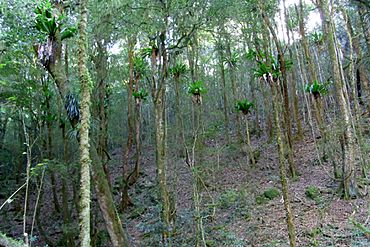Copeland Tops State Conservation Area facts for kids
Quick facts for kids Copeland Tops State Conservation AreaNew South Wales |
|
|---|---|

Bird's nest ferns growing on shatterwood trees at Copeland Tops
|
|
| Nearest town or city | Gloucester |
| Established | 1 July 2003 |
| Area | 22.01 km2 (8.5 sq mi) |
| Managing authorities | NSW National Parks and Wildlife Service |
| Website | Copeland Tops State Conservation Area |
The Copeland Tops State Conservation Area is a special protected area in New South Wales, Australia. It's located near the Barrington Tops in the Hunter Region. This area helps protect important plants and animals. It covers about 2,201 hectares (that's about 5,439 acres). You can find it about 12 kilometers (7.5 miles) west of a town called Gloucester.
Contents
What You Can Find at Copeland Tops
This conservation area is full of interesting things to see. It has a rich history and amazing nature.
Gold Mining History
Long ago, people came here looking for gold! Gold was first found by people collecting timber in 1875. This started a small gold rush in the area.
The Mountain Maid Mine
By 1878, about a thousand people lived here, hoping to strike it rich. Most of the gold mining stopped around 1890. One famous mine was called "Mountain Maid." By the end of 1886, this mine produced a huge amount of gold: 8,819 ounces (which is about 250 kilograms!). Another mine, "Hidden Treasure," yielded 9,501 ounces (about 269 kilograms). You can still visit some old parts of these mines with a tour guide today.
Amazing Plants
Copeland Tops has different types of forests. You'll find wet sclerophyll eucalyptus forests, which have tough, leafy trees. There's also a special "dry" rainforest here.
Rainforest Trees and Ferns
Some of the rainforest trees you might see include shatterwood, black booyong, Moreton Bay fig, and white cedar. Some red cedar trees grow super tall, over 40 meters (130 feet) high!
Look closely for large epiphytic ferns. These are plants that grow on other plants, like trees, instead of in the ground. You can spot bird's nest ferns, staghorn ferns, and elkhorn ferns. They look really cool!
Wonderful Animals
This area is home to many different animals, especially marsupials. Marsupials are animals that carry their babies in a pouch.
Animals You Might See
Some of the marsupials living here include Koalas, eastern grey kangaroos, red-necked wallabies, wombats, and greater gliders. If you're lucky, you might even see some tiny microbats. These small bats like to rest in the old gold mine shafts during the day.


